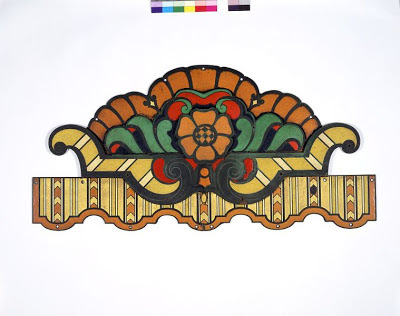 |
| Click Image to Enlarge Door Surround Raymond Hood, 1929 The Victoria & Albert Museum |
Raymond Hood (1881-1934), an American architect was the son of a well-to-do Rhode Island manufacturer of boxes who forced upon his son a strict, religious and narrow-minded education and upbringing. Following schooling at Brown University in Providence Rhode Island, Hood began to realize his own creativity, and, in 1899, proceeded to the architecture school at the Massachusetts Institute of Technology, Cambridge.
1901 saw hood join to firm of Cram, Goodhue & Ferguson, where Hood worked closely with Bertram Grosvenor Goodhue and developed a deep appreciation for Gothic tradition in American architecture, a vital counterpoint to his grounding in Beaux-Arts Classicism. I1904 brought Hood to Paris where he enrolled in the Atelier Duquesne at the Ecole des Beaux-Arts. For the next seven years, Hood traveled throughout Europe and America, and, as the curators at the V&A explain,
During this period he developed into a sharp, confident, ambitious, worldly and entertaining young architect of much potential, but with a conventional Beaux-Arts approach to style and planning. His early projects are impressive chiefly for their balance of Gothic and classical vocabularies.
By 1914, Hood had settled again in the U.S. and had opened his own firm which brought him recognition for his Bohemian sensibilities, but little paying work. His gleeful, irreverent and colorful work, however, was praised by critics who recognized Hood's creative gift. And, soon, he was heralded as a fine interior decorator as well as an architect.
1922 brought a change in Hood's fortunes when he triumphantly entered the Chicago Tribune competition, with a design for a Gothic tower. This building led to the design of the four grandest skyscrapers of New York City: the American Radiator Building (1923–5), the Daily News Building (1929–30.), the McGraw-Hill Building (1930–31) and the RCA Building at Rockefeller Center (1931–40). These buildings are Hood's greatest achievements and monuments to his creative genius, giving him a place in history as one of America's greatest architects as well as the architect who did the most to develop American Gothic.
The door surround pictured above, is a rare example of Hood's later domestic design work. Designed by Hood and crafted by the Birmingham Guild of handicraft, the enamel on bronze pediment was made for Ideal House, Argyll Street, London W1.

No comments:
Post a Comment